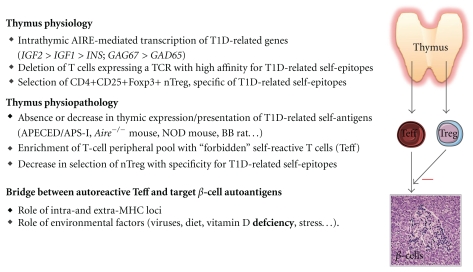Figure 1.
Thymus physiopathology and T1D development. Throughout life, the thymus selects self-tolerant and competent T cells against non-self-antigens and generates self-specific nTreg. Under control by AIRE for most of them, thymic epithelium transcribes genes encoding T1D-related antigens, as well as other neuroendocrine-related and tissue-restricted antigens. Absence or decrease in presentation of thymic T1D-related antigens (as observed in different animal models of autoimmune diabetes) conducts to the enrichment of the peripheral T-cell pool with “forbidden” self-reactive T cells (Teff) bearing a TCR directed against T1D-related epitopes, while thymic generation of specific nTreg is severely impaired. Combination of these two events is responsible for the breakdown of central self-tolerance to islet β cells. Both genetic and environmental factors are involved in the establishment of a molecular bridge between anti-β cell self-reactive Teff and islet β cell autoantigens. Once this bridge is formed, the autoimmune pathogenic response is triggered and leads to a progressive destruction of the β cell mass.

